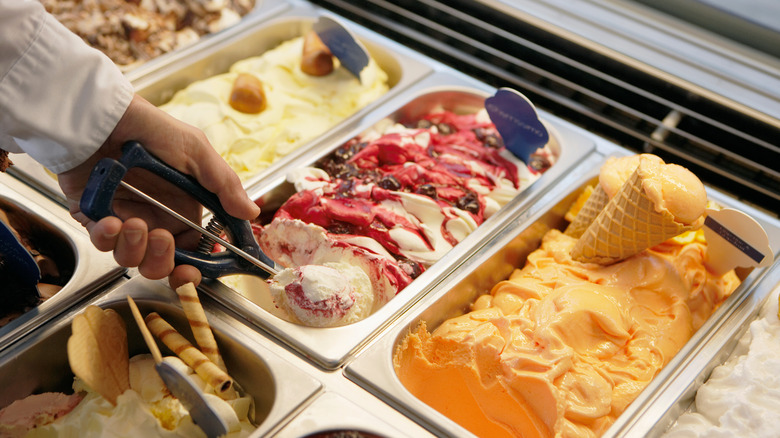The Colonial Origins Of The Term 'Ice Cream'
Whether you like yours on a cone, in a cup, or on a pie, chances are you've probably eaten a scoop or two of ice cream before. These days, with the rise of vegan, dairy-free, and even low-calorie ice cream brands, just about everyone can enjoy this sweet treat, no matter what their dietary restrictions may be. And it sure seems like most people want a taste. According to a survey conducted by Harris Poll, in 2015 ice cream was the most popular summer treat among Americans, but its popularity certainly isn't anything new.
Ice cream is one of the oldest desserts in the world, with its origins dating all the way back to at least Ancient Rome (per ThoughtCo.). But it wasn't exclusive to the Roman Empire. In 200 B.C.E., "there's a reference to people in China eating [a combination of ] milk and rice that was frozen in the snow," food historian Sarah Wassberg Johnson explained to Reader's Digest. However, this method of preparing this sweet frozen treat presented some difficulties in countries that didn't have snow. In the eras before refrigeration, people couldn't just open their freezer and take out a carton of Ben and Jerry's whenever they had a craving. But Ancient Romans didn't let that stop them.
Ice cream used to be available only to royalty
The Roman emperor Nero reportedly satisfied his sweet tooth by ordering workers to carry glacial ice down from the mountains, which he then flavored with fruit toppings, (per ThoughtCo.). A similar technique was employed in places around the Middle East, where wealthy people could pay for ice and snow that had been transported from nearby mountaintops. In the 11th century, innovative Persians created a concoction of ice, sugar, and flavorings called "sharbat," which is considered to be the predecessor to modern-day sherbet, per Reader's Digest.
Food historians believe the iced treat made its way over to Europe thanks to Marco Polo, who encountered sharbat during his travels east. According to the International Dairy Food Association, he brought the recipe back to Italy in the 13th century, where it continued to evolve over time. Because refrigeration was still so rare, this frozen sherbet was generally only served to the royal court. As it spread throughout Europe, confectioners began adding other ingredients to the iced treat, including milk, cream, butter, and eggs. In 1660, the Café Procope in Paris became the very first cafe to serve this sweet new recipe to the general public.
The first ice cream parlor opened in New York in 1776
From Europe, the iced treat eventually made its way over to America, where it was finally given its name. Prior to colonial times, what we now know of as ice cream didn't really have a singular name. However, American colonists would change all that, starting with the advent of the world's first ice cream parlor. Whereas in the old days, ice cream fans would have to trudge over mountains to get their hands on some ice cream, colonial New Yorkers only had to walk to Phillip Lenzi's confectionery shop, which began selling ice cream "almost every day" around 1776, according to Taste Cooking. Lenzi's parlor not only helped launch America's love affair with ice cream, but it also helped give them a name to call their favorite new treat.
While previous iterations of the frozen dessert had been called other names, such as sherbet and creamed ice, colonial Americans took to calling the frozen snack "iced cream," as an apt description of a dessert that was made of cream, to which ice, as well as sugar, had been added (via ThoughtCo.). Over time, they dropped the "d" at the end of the word, shortening it simply to ice cream. That name stuck, as did the American people's fondness for this sweet, refreshing frozen treat.


